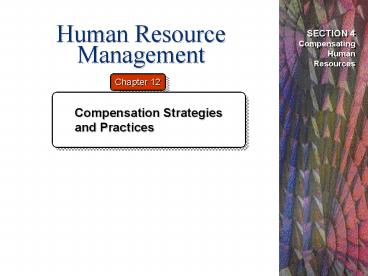Human Resource Management - PowerPoint PPT Presentation
1 / 38
Title:
Human Resource Management
Description:
Describe three considerations affecting perceptions of pay fairness. ... information technology, professional, supervisory, management, and executive ... – PowerPoint PPT presentation
Number of Views:285
Avg rating:3.0/5.0
Title: Human Resource Management
1
Human ResourceManagement
SECTION 4CompensatingHuman Resources
Chapter 12
- Compensation Strategiesand Practices
2
Learning Objectives
- After you have read this chapter, you should be
able to - Identify two general types of compensation and
the components of each. - Give examples of two different compensation
philosophies in organizations. - Discuss four strategic compensation design
issues. - Describe three considerations affecting
perceptions of pay fairness. - Identify the basic provisions of the Fair Labor
Standards Act (FLSA).
3
Learning Objectives (contd)
- Define job evaluation and discuss four methods
for of performing it. - Outline the process of building a wage and salary
administration system. - Discuss how to establish a pay-for-performance
system.
4
Compensation Systems
- Objectives of an Effective Compensation System
- Legal compliance with all appropriate laws and
regulations - Cost effectiveness for the organization
- Internal, external, and individual equity for
employees - Performance enhancement for the organization
5
Nature of Compensation
- Types of Rewards
- Intrinsic
- Intangible, psychological and social effects of
compensation - Extrinsic
- Tangible, monetary and nonmonetary effects of
compensation
6
Components of A Compensation Program
Figure 121
7
Direct Compensation
8
Typical Division of HR Responsibilities
Compensation
Figure 122
9
Continuum of Compensation Philosophies
Figure 123
10
Compensation Approaches
Figure 124
11
Compensation Quartile Strategies
Figure 125
12
Decisions About Compensation Levels
13
Perceptions of Pay Fairness
14
Equity Considerations in Compensation
Figure 127
15
Fair Labor Standards Act (FSLA) of 1938
Provisions of the Act
Minimum wage requirement sets wage floor
Child labor (under 14 years old) is prohibited
Requires overtime payments for non-exempt
employees
Exempts highly-paid computer workers
Requires overtime (1½) pay for hours over 40 hours
Requires compensatory time at overtime (1½) pay
rates
16
Wage/Hour Status Under Fair Labor Standards Act
Figure 128a
17
Wage/Hour Status Under Fair Labor Standards Act
Figure 128b
18
Wage/Hour Status Under Fair Labor Standards Act
Figure 128c
19
The IRS Test for Employees andIndependent
Contractors
Source U.S. Internal Revenue Service.
Figure 129
20
Other Laws Affecting Compensation
- Davis-Bacon Act of 1931
- Required payment of prevailing wage by firms
engaged in federal construction projects. - Walsh-Healy Public Contracts Act and the Service
Contracts Act - Extended the payment of prevailing wage to
service contracts - Required overtime payment for any employee hours
worked over eight hours in one day applies only
to to federal contracts, not the private sector.
21
Pay and Gender
- Equal Pay Act of 1963
- Requires that men and women be paid the same for
performing substantially similar jobs with
limited non-gender exceptions (e.g., merit and
seniority). - Issue of Pay Equity
- Similarity in pay for all jobs requiring
comparable level of knowledge, skills, and
abilities, even if actual duties and market rates
differ significantly.
22
Compensation Administration Process
Figure 1210
23
Job Evaluation
- Job Evaluation
- The systematic determination of the relative
worth of jobs within an organization. - Benchmark Job
- A job found in many organizations and performed
by several individuals who have similar duties
that are relatively stable and require similar
KSAs.
24
Job Evaluation
Ranking
Classification
Job Evaluation Methods
FactorComparison
PointMethod
25
Job Evaluation Point Chart
Figure 1211
26
Legal Issues and Job Evaluation
Job Evaluation
27
Developing Pay Surveys
Select Employers with Comparable Jobs
Determine Jobs to be Surveyed
Decide What Information Is Needed
Conduct Survey
28
Pay Structures
- Market Line
- The line on a graph showing the relationship
between the job value, as determined by job
evaluation points, and pay survey rates. - Common Pay Structures
- Hourly and salaried
- Office, plant, technical, professional,
managerial - Clerical, information technology, professional,
supervisory, management, and executive
29
Establishing Pay Structures
Figure 1212
30
Pay Structures (contd)
- Pay Grades
- A grouping of individual jobs having
approximately the same job worth. - Broadbanding
- The practice of using fewer pay grades having
broader pay ranges that in traditional systems. - Benefits
- Encourages horizontal movement of employees
- Is consistent with trend towards flatter
organizations - Creates a more flexible organization
- Encourages competency development
- Emphasizes career development
31
Traditional Pay Structure vs. Broadbanding
Figure 1213
32
Pay Scattergram
Figure 1214
33
Typical Pay Range Widths
Figure 1215
34
Example of Pay Grades and Pay Ranges
Figure 1216
35
Pay Rate Issues
- Rates Out of Range
- Red-Circled Employees
- An incumbent (current jobholder) who is paid
above the range set for the job. - Green-Circled Employees
- An incumbent who is paid below the range set for
the job. - Pay Compression
- A situation in which pay differences among
individuals with different levels of experience
and performance in the organization becomes
small.
36
Issues Involving Pay Increases
- Seniority
- Time spent in an organization or on a particular
job. - Used to determine eligibility for organizational
rewards and benefits. - Maturity Curve
- A curve that depicts the relationship between
experience and pay rates. - Assumption is that as experience increases,
proficiency and performance increase.
37
Issues Involving Pay Increases
- Cost-of-Living Adjustments (COLA)
- A percentage increase in wages that allows
employees to maintain the same real wages in a
period of economic inflation. - Adjustments are tied to changes in an economic
measure (e.g., the Consumer Price Index). - Lump-Sum Increases (LSI)
- A one-time payment of all or part of a yearly pay
increase. - Lump-sum payments do not increase base wages
38
Compa-Ratio Example
- Compa-ratio
- The pay level divided by the midpoint of the pay
range.































